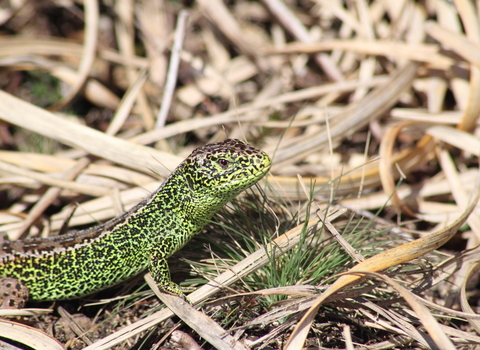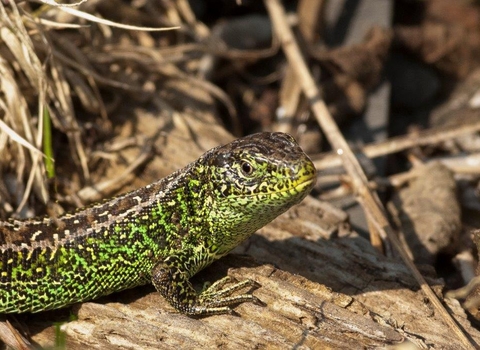
Steve Davis

©Stewart Canham
Sand lizard
The sand lizard is extremely rare due to the loss of its sandy heath and dune habitats. Reintroduction programmes have helped establish new populations.
Scientific name
Lacerta agilisWhen to see
April to OctoberTop facts
Category
Stats
Length: 20cmWeight: 15g
Average lifespan: up to 20 years
Protected in the UK under the Wildlife and Countryside Act, 1981. Priority Species under the UK Post-2010 Biodiversity Framework. Listed as a European Protected Species under Annex IV of the European Habitats Directive.
Habitats
About
The sand lizard is one of the UK's rarest reptiles. It favours sandy heathland habitats and sand dunes, and can be spotted basking on bare patches of sand. Sand lizards are confined to a few sites as destruction of their habitat has reduced their range.Males emerge from hibernation in spring, turning a bright green colour as they get ready to mate. Females lay their eggs in the sand in June and July, and the young hatch one to two months later.
What to look for
Female sand lizards are a sandy-brown colour, with rows of dark blotches along the back; males have green flanks that are at their brightest during the breeding season, making them easy to spot.Where to find
Restricted to a few isolated areas in Dorset, Hampshire, Surrey and Merseyside. Reintroduced into other areas in the South East, South West, Lancashire, and Wales.Did you know?
The sand lizard digs burrows for shelter, both for night-time refuge and for hibernation. Burrows can be as deep as one metre, but tend to be small in diameter. Dug out of sandy soil, the entrance is usually hidden in the undergrowth and turns sharply after just a few centimetres so that the lizard is concealed when inside. Sometimes, sand lizards dig their own hibernation burrow within the walls of a rabbit warren.The Wildlife Trusts are working to restore and protect our heathlands and coastal habitats by promoting good management, clearing encroaching scrub and implementing beneficial grazing regimes. The Wildlife Trusts have also been involved with conservation projects to reintroduce the sand lizard to its former range.
